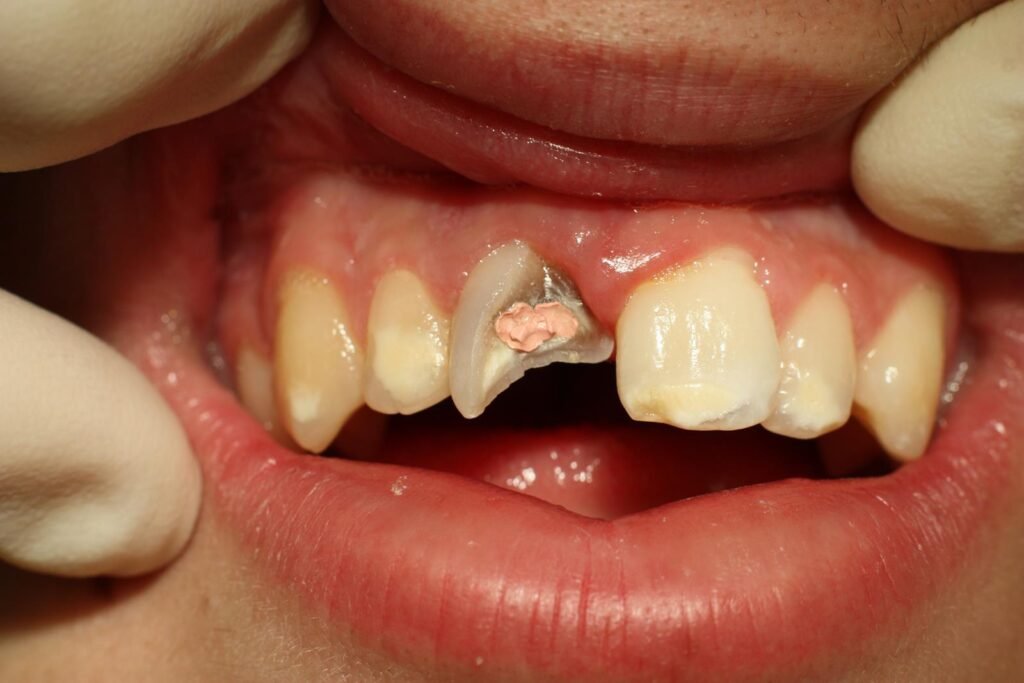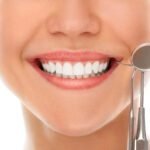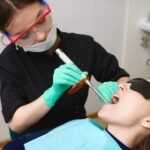Table of Contents
Recognizing the Emergency Situation
Recognizing an emergency situation is crucial when it comes to handling dental injuries in children. As a parent, it is important to be able to quickly identify when a dental issue requires immediate attention. There are several signs that can indicate an urgent situation.
One of the most obvious signs is severe pain. If your child is experiencing intense, persistent pain in their mouth or teeth, it is likely a dental emergency. Additionally, excessive bleeding, especially if it does not stop after applying pressure, should be taken seriously. Swelling or inflammation in the gums or face can also be indicative of a serious problem. Lastly, if a tooth has been completely knocked out, time is of the essence as it may be possible to save the tooth if prompt action is taken.
By being aware of these signs and symptoms, you can quickly recognize when a dental situation requires immediate attention. Doing so will allow you to take the necessary steps to ensure your child receives the appropriate treatment as soon as possible.


Assessing the Severity of the Injury
Assessing the severity of a dental injury is crucial in determining the appropriate course of action and seeking immediate dental care if necessary. When faced with a dental emergency involving your child, it is important to carefully evaluate the injury to determine its severity.
Start by inspecting the affected area for visible signs of trauma. Look for any bleeding, swelling, or discoloration around the mouth or teeth. If there is bleeding, apply gentle pressure with a clean cloth to control it. Additionally, check for any broken or missing teeth, as these often indicate a more severe injury.
Next, gently feel around the injured area to assess for any tenderness or pain. The intensity of pain can provide insight into the severity of the injury. Assess whether your child can still move their jaw and if there are any restrictions or discomfort in doing so.
If your child is experiencing severe pain, difficulty breathing or swallowing, or if there is a significant amount of blood loss, it is essential to seek immediate professional dental care. These are indications of a more serious injury that requires immediate attention. Remember, early intervention is key in preventing further complications and ensuring optimal dental health for your child.
In less severe cases, where the injury doesn’t appear life-threatening and your child is stable, you can consider managing the situation at home. However, it is always recommended to consult with a dental professional to ensure the best possible care and outcome for your child’s dental health.
Remaining Calm and Comforting Your Child
Remaining calm and comforting your child in an emergency situation is crucial to ensure their well-being and to alleviate their fear and anxiety. As a parent, it is important to stay composed and project a sense of reassurance, even though you may be feeling overwhelmed yourself. Children often look to their parents for guidance and comfort, so your demeanor and approach can greatly impact their emotional state.
Start by taking a deep breath and assessing the situation calmly. Maintain a gentle and soothing tone of voice as you speak to your child, reassuring them that everything will be alright. Avoid panicking or displaying any signs of distress, as this can escalate their anxiety. Instead, use calm and simple language to explain the situation and what steps need to be taken.
Comfort your child by offering physical closeness and a gentle touch. Holding their hand or giving them a hug can provide them with a sense of security and help to calm their nerves. Stay by their side throughout the process, assuring them that they are not alone in this situation.
Remember, remaining calm and comforting your child during a dental emergency is crucial to help them feel safe and supported. Your presence and reassurance will go a long way in easing their distress and making the situation more manageable for both of you.


Checking for Additional Injuries
After ensuring the safety of your child in an emergency situation and calming them down, it is important to check for any additional injuries. Although the focus may initially be on the dental injury, it is crucial to assess the overall condition of your child to ensure their well-being.
Start by carefully examining your child’s face, head, and neck for any signs of swelling, bruising, or bleeding. Look for any lacerations or other visible injuries that may require immediate medical attention. It is essential to remain calm and composed during this process to prevent any further distress to your child.
Next, assess if your child is experiencing any pain or discomfort in other areas of their body. Ask them if they are feeling any pain in their neck, back, or limbs. Observe their movements for any signs of restricted mobility or difficulty in performing certain actions. If you notice any concerning symptoms, it is important to seek medical help immediately.
Remember, while the dental injury may be the primary concern, it is vital to consider the possibility of additional injuries. By checking for any signs of trauma beyond the oral cavity, you can ensure that your child receives appropriate medical attention and proper care.
Handling a Chipped Tooth
Chipping a tooth can be a startling experience, especially for children. As a parent, it’s important to remain calm and take the necessary steps to handle the situation effectively. First and foremost, make sure your child feels safe and comforted. Assure them that you are there to help and that everything will be alright.
Next, assess the severity of the chip. If it’s a minor chip, there may not be any immediate pain or discomfort. However, if the chip is larger or exposes the inner layers of the tooth, your child may experience sensitivity or pain. In such cases, it’s crucial to contact a dentist as soon as possible for professional assessment and treatment. Remember, taking prompt action can prevent further damage and ensure the best possible outcome for your child’s dental health.
Handling a chipped tooth requires careful consideration and expertise. Stay tuned for the rest of this article to learn more about the necessary steps to take, how to properly retrieve and store a knocked-out tooth, and when to seek emergency dental care. Your child’s dental health is of utmost importance, and being well-informed will help you navigate these situations with confidence and ease.


Handling a Cracked Tooth
A cracked tooth can be a distressing situation for both parents and children alike. It is important to handle this situation with care and seek immediate dental attention. Cracks in teeth can vary in severity, from superficial cracks known as craze lines to more severe fractures that extend into the root or pulp of the tooth.
When dealing with a cracked tooth, it is crucial to remain calm and reassure your child. Comfort them and let them know that help is on the way. Avoid touching the affected area or trying to examine the crack yourself, as this can potentially cause further damage. Instead, focus on providing immediate relief by applying a cold pack or compress to the outside of the cheek or lip near the affected tooth. This can help reduce pain and swelling while waiting for professional dental care.
Remember, a cracked tooth requires prompt attention from a pediatric dentist to prevent further complications. Do not delay in contacting emergency dental care to schedule an appointment. They can assess the severity of the crack, recommend appropriate treatment options, and provide necessary pain relief measures. By seeking immediate professional help, you can ensure the best possible outcome for your child’s oral health.
Handling a Knocked-Out Tooth
Once a tooth has been knocked out, it is crucial to act quickly and appropriately to increase the chances of saving the tooth. Time is of the essence, as the longer the tooth is out of the socket, the less likely it is to be successfully reimplanted. Remember to remain calm in order to provide the best care for your child in this emergency situation.
The first step in handling a knocked-out tooth is to retrieve it properly. Make sure to hold the tooth by the crown, which is the top part that is usually visible in the mouth, and avoid touching the root. Touching the root can damage the delicate tissues that are essential for the tooth’s reattachment. Gently rinse the tooth with tap water if it is dirty, but do not scrub or use any cleaning agents. It is important to handle the tooth with care to preserve its viability.


Retrieving the Knocked-Out Tooth Properly
When a tooth gets knocked out, it is crucial to retrieve it properly in order to have the best chance of successful reimplantation. Time is of the essence, as the chances of saving the tooth decrease significantly after the first 30 minutes. If your child experiences a knocked-out tooth, follow these steps to retrieve it properly:
1. Handle the tooth with care: When picking up the tooth, avoid touching the root or any tissue still attached to it. Only hold the tooth by the crown, which is the visible part in the mouth. Touching the root can damage the cells necessary for successful reattachment.
2. Avoid cleaning or scrubbing the tooth: It may be tempting to rinse off the tooth with water or brush off any debris, but it is important to resist this urge. Cleaning the tooth can cause further damage. Instead, gently rinse it with milk or a sterile saline solution if it is visibly dirty. Otherwise, simply leave it as it is.
Remember, time is of the essence in cases of knocked-out teeth. By handling the tooth with care and avoiding unnecessary cleaning, you can increase the chances of successful reimplantation. In the next section, we will discuss how to properly store the knocked-out tooth to preserve its viability until emergency dental care can be sought.
Rinsing the Knocked-Out Tooth
To protect the fragile structure of a knocked-out tooth, it is crucial to handle it with care. One step in preserving the tooth’s viability is rinsing it gently with saline solution or milk. This helps remove debris or dirt that may be present on the surface, which could potentially cause infection if left untreated. It is important to note that tap water should not be used for rinsing the tooth, as it may contain contaminants that could harm the tooth or its root.
After rinsing the knocked-out tooth, it should be held by the crown, which is the visible part of the tooth, and not by the root. The root of the tooth is sensitive and vulnerable, so it is vital to avoid touching or scrubbing it. If there are any visible fragments of tissue or blood on the tooth, these can be gently wiped off using a clean, moist cloth or gauze. Remember, excessive handling or forceful cleaning can damage the delicate structures of the tooth and reduce the chances of successful re-implantation.
Storing the Knocked-Out Tooth
Storing the knocked-out tooth properly is crucial in increasing the chances of successful re-implantation. Time is of the essence, so it’s important to act quickly and efficiently. When handling the tooth, make sure to only touch the crown and avoid touching the root. It’s essential to keep the tooth moist to prevent it from drying out, as this can lead to irreversible damage. You can store the tooth in various ways, but the best method is to place it in a container filled with milk or a saline solution. These solutions help to preserve the tooth’s vitality and provide an environment that is similar to the oral cavity. Avoid using water or simply wrapping the tooth in tissue paper, as they do not provide the same level of protection and moisture.
Once the tooth is safely stored, it’s crucial to seek emergency dental care immediately. Time is a critical factor in the successful re-implantation of a knocked-out tooth. Contact your dentist or a dental emergency service to book an appointment as soon as possible. They will provide expert guidance on the next steps to take and will be equipped to handle such emergencies. Remember, the sooner the tooth is re-implanted, the better the chances of a successful outcome. In the meantime, you can use a cold compress to help reduce any swelling and discomfort your child may be experiencing. Placing a cold pack or a bag of ice wrapped in a towel on the affected area for 15-20 minutes at a time can provide relief and minimize pain.
Contacting Emergency Dental Care
When faced with a dental emergency involving your child, it is crucial to contact emergency dental care as soon as possible. Dental emergencies can be stressful and intimidating, but prompt action can make a significant difference in the outcome and overall dental health of your child.
Dental emergencies can include a variety of situations, such as a knocked-out tooth, a chipped or cracked tooth, severe toothache, or bleeding in the mouth. These situations require immediate attention from a dental professional to ensure proper diagnosis and appropriate treatment. By contacting emergency dental care, you can receive guidance on how to manage the situation before reaching the dental office, which can help alleviate any discomfort your child may be experiencing and prevent further damage to their teeth or oral tissues.
Using a Cold Compress
Applying a cold compress can be an effective first-aid measure to alleviate pain and reduce swelling after a dental injury. The cold temperature helps to constrict blood vessels, which can help to minimize bleeding and inflammation in the affected area.
To use a cold compress, wrap a clean cloth or ice pack in a thin towel and apply it gently to the injured area for about 15 minutes. It is important to avoid direct contact between the cold compress and the skin, as this can cause ice burns. Applying the cold compress intermittently, with short breaks in between, can provide the best results.
Remember, using a cold compress is just a temporary measure to provide relief until you can seek professional dental care. If your child has sustained a dental injury, it is crucial to contact emergency dental care immediately. They can assess the severity of the injury and provide appropriate treatment to ensure the best outcome for your child’s dental health.
Managing Pain and Swelling
To manage pain and swelling after a dental emergency, it is important to follow proper care instructions and take appropriate measures. One effective way to reduce pain and swelling is by using a cold compress. Applying a cold compress to the affected area can help numb the area and reduce inflammation. Wrap a few ice cubes in a clean cloth or use a cold pack, and gently apply it to the outside of the cheek near the injured tooth. Keep it in place for about 15 minutes at a time, with short breaks in between. This simple technique can provide immediate relief and help alleviate discomfort.
In addition to using a cold compress, over-the-counter pain relievers can also be helpful in managing pain and reducing swelling. However, it is important to consult with a dentist or a healthcare professional before taking any medication, especially for children. They can provide guidance on the appropriate dosage and type of medication that is safe and effective for your child’s specific situation. Remember to always follow the instructions on the packaging and never exceed the recommended dosage. By promptly addressing pain and swelling, you can provide your child with the relief they need and minimize potential complications.
Avoiding Certain Foods and Activities
To protect your child’s dental health and promote healing after a dental injury, it’s important to be aware of certain foods and activities that should be avoided. These precautions will help prevent further damage and ensure a smooth recovery.
First and foremost, it’s crucial to avoid hard and crunchy foods, as they can aggravate the injured area and potentially cause additional discomfort. Foods such as nuts, chips, and hard candies should be temporarily avoided. Opt for softer alternatives like mashed potatoes, yogurt, and soup to provide adequate nutrition while minimizing irritation.
In addition to avoiding hard foods, it’s important to steer clear of activities that may pose a risk to the injured tooth or area. This includes avoiding contact sports or any other activities that may result in a blow to the mouth. It’s wise to encourage your child to take it easy and temporarily refrain from engaging in physical activities that could potentially worsen the injury.
By being mindful of what your child eats and the activities they participate in, you can significantly contribute to their oral health and aid in the healing process. Remember to consult with a dental professional for specific guidelines tailored to your child’s injury, as they will provide personalized recommendations based on the severity of the situation.
Maintaining Good Oral Hygiene
Maintaining good oral hygiene is crucial for overall dental health, especially after a dental emergency. Even though the immediate focus may be on treating the injury, it is important to continue practicing good oral hygiene to prevent further complications.
After an emergency situation, it is common for children to experience discomfort or pain in the affected area. This can make brushing and flossing difficult or uncomfortable. However, it is essential to continue with regular oral hygiene practices to prevent the buildup of plaque and bacteria.
To ensure proper oral hygiene, gentle brushing should be done at least twice a day using a soft-bristled toothbrush and fluoride toothpaste. Additionally, flossing should be incorporated into the daily routine to remove food particles and plaque from in between the teeth. Encouraging your child to rinse with a fluoridated mouthwash can also help prevent cavities and maintain a healthy smile.
Furthermore, it is advisable to follow the instructions provided by the dentist regarding any special precautions or adjustments to oral hygiene practices following a dental emergency. This may include using a special mouth rinse or avoiding certain areas of the mouth during brushing and flossing. By maintaining good oral hygiene, your child can recover from the dental emergency and continue to enjoy a healthy and vibrant smile.
Following Up with a Dentist
Following up with a dentist is crucial after your child has experienced a dental emergency. Even if the immediate issue has been resolved, it is important to have a professional evaluate the situation and ensure that there are no underlying problems. A dentist has the expertise and experience to perform a thorough examination and provide appropriate treatment if necessary.
During the follow-up visit, the dentist will examine the affected area and may take X-rays to get a clearer view of the teeth and supporting structures. They will carefully assess the healing process and ensure that there are no complications. Additionally, the dentist may discuss any necessary preventive measures or future treatments that may be required to maintain your child’s oral health.
It is recommended to follow the dentist’s advice and schedule regular check-ups to monitor the progress and overall oral health of your child. By doing so, you can address any potential issues promptly and prevent further complications. Remember, the well-being of your child’s dental health is important for their overall well-being, so make sure to follow up with a dentist after a dental emergency.
How do I know if my dental injury is an emergency?
Recognizing the emergency situation can involve severe pain, excessive bleeding, a broken or displaced tooth, or any injury that affects your ability to breathe or swallow.
What should I do if my child has a chipped tooth?
Handling a chipped tooth requires rinsing the mouth with warm water, applying a cold compress to reduce swelling, and contacting a dentist for further evaluation.
What steps should I take for a cracked tooth?
Handling a cracked tooth involves rinsing the mouth with warm water, using a cold compress to minimize swelling, and contacting a dentist for an assessment and potential treatment.
What is the proper way to handle a knocked-out tooth?
Retrieving the knocked-out tooth properly includes holding it by the crown, rinsing it gently with water, and placing it back into the socket or storing it in milk or a tooth preservation kit.
How should I contact emergency dental care?
Contacting emergency dental care involves calling your dentist’s emergency line or seeking assistance at a local dental clinic or hospital.
How can I manage pain and swelling after a dental injury?
Managing pain and swelling can be done by using a cold compress, taking over-the-counter pain relievers, and following any recommendations provided by your dentist.
Are there any foods or activities I should avoid after a dental injury?
Avoiding certain foods and activities, such as chewing on hard or sticky foods and participating in contact sports, can help prevent further damage to the injured tooth or area.
What can I do to maintain good oral hygiene after a dental injury?
Maintaining good oral hygiene involves gently brushing your teeth, avoiding the injured area, and rinsing your mouth with saltwater to promote healing.
How soon should I follow up with a dentist after a dental injury?
It is recommended to follow up with a dentist as soon as possible after a dental injury, even if there is no immediate pain or visible damage, to ensure proper evaluation and treatment.
Can a cracked tooth heal on its own without seeing a dentist?
No, a cracked tooth cannot heal on its own. It requires professional dental treatment to prevent further damage and potential infection.




